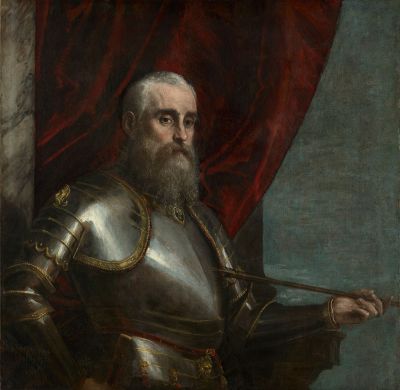In the Armor Court of the Cleveland Museum of Art may be seen an impressive portrait of Agostino Barbarigo (1516-1571), a member of a patrician family that helped rule Venice in the 15th and 16th centuries. Two of Agostino’s ancestors had become doges of the Republic. Agostino himself was a prominent diplomat and military commander who became second in command of the Venetian naval forces during the Battle of Lepanto in 1571.
The Republic of Venice was a sovereign state and a major maritime power which existed for over 1,000 years between 800 and the 1800s. The Republic was ruled by the Doge, who was elected by members of the Great Council of Venice, the city-state’s parliament. The ruling class was an oligarchy of merchants and aristocrats. In the Middle Ages, Venice became extremely wealthy through its control of trade between Europe and the eastern Mediterranean and beyond. The Venetians achieved extensive trading privileges in the Byzantine Empire during the 12th century and were major importers of silks, ivories and luxury metalwork through Constantinople. Over time, the Republic of Venice expanded its territory along the Dalmatian coast and into Greece. The Venetians controlled many of the Aegean islands as well as Crete and Cyprus. It was in the early 1400s, however, that another expanding power, the Ottoman Empire, began to wage war with the Venetian Republic, a conflict that would last into the 1600s.
The Portrait of Agostino Barbarigo references one such clash, the Battle of Lepanto, a naval engagement taking place on Oct. 7, 1571. It involved a coalition of Catholic maritime states arranged by Pope Pius V forming a large naval fleet known as the Holy League. It included the Venetians under the command of Agostino Barbarigo. Their task was to confront the fleet of the Ottoman Empire which had encircled Cyprus, then under the control of Venice. The Ottoman forces sailed westwards from their naval station in Lepanto where they met the fleet of the Holy League sailing east from Messina. The Venetians and their allies prevailed in battle by inflicting defeat on the Ottomans, yet Agostino Barbarino was tragically killed on the deck of his galley by a Turkish arrow. He is shown in his portrait holding the arrow that killed him.
Barbarino’s portrait depicts him as a middle-aged man with a long beard. He wears the field armor of a military commander enlivened by red velvet pickadils, gilt edges and lion mask appliqués, probably a reference to the Venetian Republic symbolized by the Lion of Saint Mark. The origins of this painting are obscure. It is reasonable to assume it was commissioned as a memorial to Barbarigo, possibly by a member of his family, shortly after his death in 1571.
The artist was Paolo Veronese (1528-1588), one of Venice’s great painters. Veronese took his name from his birthplace of Verona, then the largest possession of Venice on the mainland. The census in Verona attests that Veronese was born sometime in 1528 to a stonecutter, or spezapreda, named Gabriele, and his wife Catherina. Veronese moved to Venice in 1553 after obtaining his first state commission, ceilings in fresco decorating the Sala dei Cosiglio dei Dieci (the Hall of the Council of Ten) and the adjoining Sala dei Tre Capi del Consiglio in the Doge’s Palace, in the new rooms replacing those lost in the fire of 1547. He then painted a “History of Esther” in the ceiling for the church of San Sebastiano (1556–57). It was these ceiling paintings and those of 1557 in the Marciana Library (for which he was awarded a prize judged by Titian and Sansovino) that established him as a master among his Venetian contemporaries. Already these works indicate Veronese’s mastery in reflecting both the subtle foreshortening of the figures of Correggio and the heroism of those by Michelangelo. Veronese is considered a supreme colorist as may be noted by the red velvet curtain behind Barbarigo in the portrait. He is also studied today as one of the great trio of Venetian painters of the Cinquecento including Tintoretto and Titian.
The details of the commission for the Portrait of Agostino Barberino are not known. However, Veronese is known to have also painted a large canvas depicting the Battle of Lepanto around the same time as the Barbarigo portrait, that is shortly after the battle in 1571. This painting is today in the Gallerie dell’Accademia in Venice. It was originally placed on the left of the altar of the Rosary in the church of St. Peter Martyr on Murano, probably as an ex-voto commissioned by Pietro Giustiniani of Murano who also took part in the naval battle at Lepanto on Oct. 7, 1571 when the Turkish fleet was defeated thanks mainly to the Venetian ships. The play of tone and light in the lower part depicting the battle is masterly. In the upper part, above a curtain of cloud, the Saints Peter, Roch, Justine, and Mark implore the Virgin to grant victory to the Christian fleet. In answer to this, an angel hurls burning arrows at the Turkish vessels. Is it possible the Cleveland painting was part of this same commission and destined for the same church?
The “Portrait of Agostino Barbarigo” in the Cleveland Museum of Art is not only the work of a great Venetian painter, but also captures an important historical figure at a specific moment in time when Venetian power in the Mediterranean was at its peak. Though the economic vitality of the Venetian Republic had started to decline in the late 16th century due to movement of international trade towards the Atlantic, its political regime still appeared in the 1700s as a model for the philosophers of the Enlightenment.



